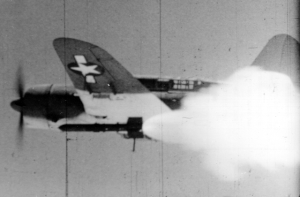Tiny Tim (rocket)
| Tiny Tim rocket | |
|---|---|
 SB2C Helldiver firing a Tiny Tim rocket | |
| Type | Rocket |
| Place of origin | United States |
| Service history | |
| In service | 1944-1951 |
| Used by | USN |
| Wars | World War II, Korean War |
| Production history | |
| Designer | Caltech, NOTS |
| Designed | 1944 |
| Specifications | |
| Mass | 583 kg |
| Length | 3.12 m |
| Width | 91 cm |
| Muzzle velocity | 245.8 m/s |
| Maximum firing range | 1,500 m |
The Tiny Tim, was an American air to ground rocket used near the end of the Second World War. One source states it was built in response to a US Navy requirement for an anti-shipping rocket capable of hitting ships outside of their anti-aircraft range, with a payload capable of sinking heavy shipping.[1] However, according to the China Lake Weapons Digest,[2] the Tiny Tim was
... designed by the Caltech-China Lake team as a bunker-buster, Tim was the first large aircraft rocket, and, although it saw only limited service in WWII, it helped form the foundations of many postwar developments in rocketry.
Tiny Tim had a 150 lb (68 kg) high explosive warhead, and had a maximum range of 1,500 meters (1,640 yards).
They were used by the US Navy and US Marine Corps near the end of the war during the battle of Okinawa, and during the Korean war. A problem with the sheer power of the rocket motor causing damage to the firing aircraft was resolved by having the Tiny Tim drop like a bomb, and a lanyard attached to the rocket would snap, causing the rocket to ignite[3]. Common targets included coastal defense guns, bridges, pill boxes, tanks, and shipping.[4] An ambitious operation to use the Tiny Tim against German V-1 sites as part of Operation Crossbow, code-named Project Danny, was planned but cancelled before the squadrons assigned could be deployed to Europe.
Common Tiny Tim delivery aircraft during the Second World War include the F4U Corsair, F6F Hellcat, TBM Avenger, and the SB2C Helldiver.[5]
See also
References
- ^ Parsch, A: "Caltech/NOTS", paragraph 1, "Designation-Systems.Net", 13 July 2004.
- ^ "China Lake Weapons Digest".
- ^ Slover, G: "Chapter-11-C, 11C3. Suspension and launching of aircraft rockets", "Gene Slover".
- ^ Smithsonian National Air & Space Museum: "Missile, Air-to-Surface, Tiny Tim", "National Air & Space Museum", 2005.
- ^ Parsch, A: "Caltech/NOTS", paragraph 3, "Designation-Systems.Net", 13 July 2004.
